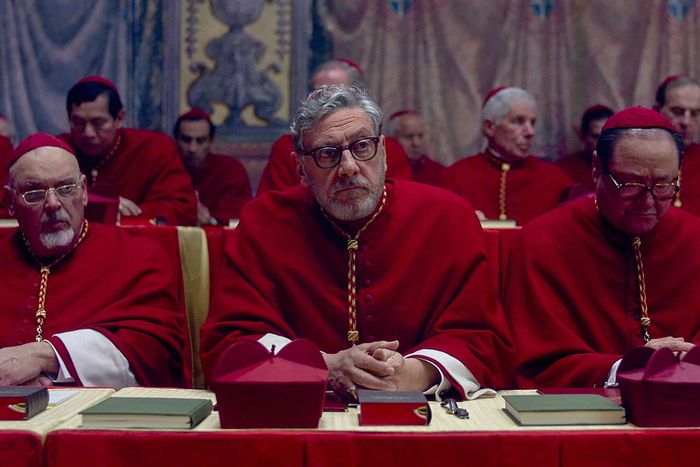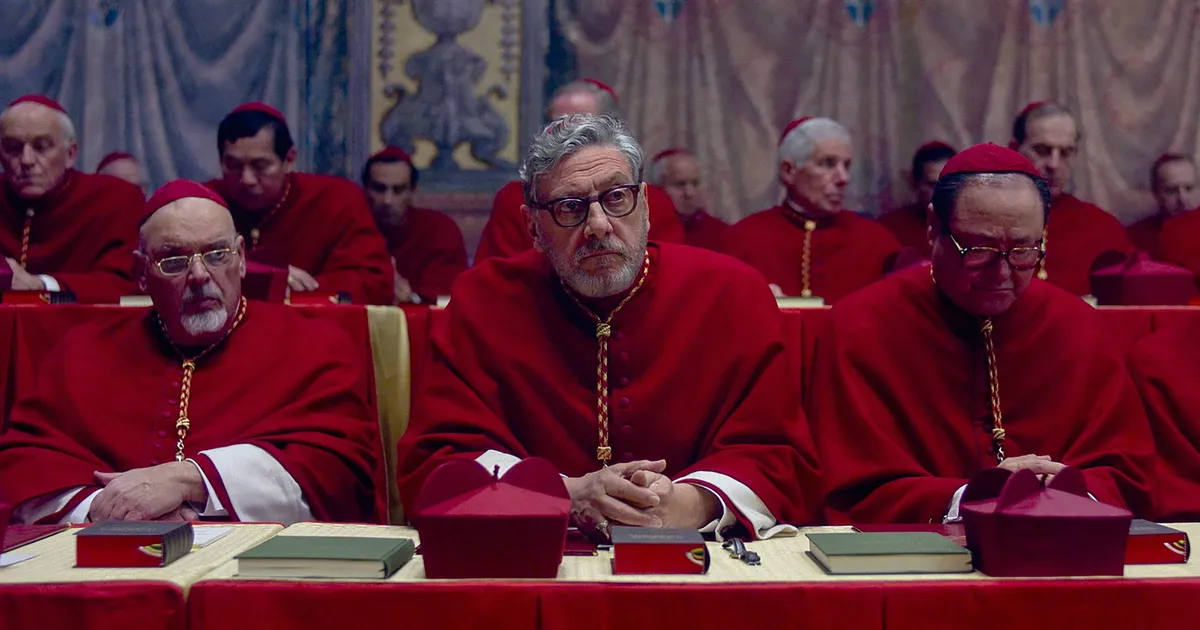
Photo: Focus Features/Everett Collection
No other movie in last year’s Oscar race proved as unintentionally timely as Conclave. In the weeks leading up to the ceremony, the twisty turns and petty politicking of Edward Berger’s film made it a handy metaphor for awards season itself. Now, fate has brought a more literal comparison: The death of Pope Francis on April 21 means we’re getting a real-life conclave, just like in the movie Conclave! (Ironically, the film was briefly unavailable to stream in the wake of Francis’s death, but you can now find it on Prime Video.)
For the godless heathens among us, it’s only natural to filter these proceedings, too, through the prism of an award-winning adult drama. The days of discussing which Oscar movie best represents which Conclave character have ended. It’s time to turn our attention to an even more difficult question: How do the actual papabiles (Latin for “pope-able”) match up to the figures we know and love from Conclave? Most of them are fairly obscure to laymen, and, unfortunately, none of them are played by veteran character actors having fun chewing the scenery in a prestige-tinted procedural. But still, I’ve found a few shocking similarities between the characters in the fictional conclave and those who will soon journey to Rome to choose the next pontiff.
So here’s a guide to the cardinals of the real-life conclave, written by someone who is not even Catholic but has read many, many, many, many, many explainers on the various cardinals and, just as important, seen Conclave three times.
Photo-Illustration: Vulture; Photos: Focus Features/Everett Collection, Riccardo De Luca/Anadolu via Getty Images
In Conclave, it falls to Ralph Fiennes’s Cardinal Lawrence, the dean of the College of Cardinals, to preside over the proceedings. But our real-life dean, 91-year-old Giovanni Battista Re, is too old to take part in the conclave, so the task falls to the most senior cardinal: Pietro Parolin, a bureaucratic insider who served as the Vatican’s secretary of state. Like Lawrence, he was close to the late pope and is thought to share similar views, but he’s considered slightly more moderate and diplomatic. However, there’s one big difference between Parolin and Fiennes’s Oscar-nominated cardinal: While Lawrence began the proceedings as a dark horse, only attaining momentum after multiple ballots, Parolin enters the conclave as one of the betting favorites.
Honorable mention: Reinhard Marx, archbishop of Munich, who, like Lawrence, attempted to resign his post — here as a gesture of atonement for the Church’s mishandling of sexual abuse — but was turned down by Francis.
Photo-Illustration: Vulture; Photos: Focus Features/Everett Collection, Vandeville Eric/ABACA/Shutterstock
One element of this conclave that Conclave anticipated is that, while there are multiple cardinals who could plausibly claim to follow in the progressive footsteps of Pope Francis, the conservative opposition appears to be represented by one big name. Here, it’s Péter Erdő, the primate of Hungary, who has at times aligned himself with President Viktor Orbán’s anti-immigrant politics. (In 2016, he compared churches sheltering migrants to human trafficking, though he reportedly softened his stance after discussions with Francis.) Per the New York Times, Erdő has spoken at length about the Church’s need to “guard the flame” of Christianity, a line you can imagine Tedesco saying in an early draft of Conclave. The good news is that he’s considered more open to compromise with the Church’s liberals than his onscreen counterpart. No word yet on what his preferred flavor of vape is.
Honorable mentions: Raymond Burke, an archconservative American prelate who wanted to deny Joe Biden the Eucharist; Wim Eijk, a vocal critic of Pope Francis’s stance on divorce.
Photo-Illustration: Vulture; Photos: Focus Features/Everett Collection, Franco Origlia/Getty Images
Like Benitez, Luis Antonio Tagle is a liberal cardinal who hails from the Global South, in this case the Philippines, who has spent much of his career ministering on the ground. (Further underscoring the similarities, Benitez was Filipino in Robert Harris’s novel.) Tagle has publicly spoken out in defense of the queer community — as well as divorcées and unwed mothers — to the extent that the website Them dubbed him “the Gay Internet’s favorite papal candidate.” However, like Francis, to whom he’s often compared, Tagle still holds fairly doctrinaire views on abortion. As with Parolin, there’s little chance of Tagle repeating his Conclave alter ego’s unexpected journey to the Chair of St. Peter: As Francis’s rumored favored successor, he’s also considered one of the front-runners.
Honorable mentions: Pierbattista Pizzaballa, Latin Patriarch of Jerusalem, who also rose to prominence ministering in a conflict zone; Konrad Krajewski, a Pole who famously came to the aid of squatters and trans sex workers; Pablo Virgilio David, another Filipino cardinal, notable for his outreach to other religions as well his criticism of Israel’s war in Gaza.
Photo-Illustration: Vulture; Photos: Focus Features/Everett Collection, Roberto Serra – Iguana Press/Getty Images
An Italian widely seen as a candidate to continue in the footsteps of Pope Francis, Matteo Zuppi is a charismatic progressive in the vein of Bellini. (His name is not a cocktail, but it is close to a liquor brand.) He is famed for his inclusive approach to gay rights and immigration, as well as his love of bicycling around Bologna, which you can absolutely imagine Stanley Tucci doing. Zuppi also recently served as a wartime envoy to Ukraine, which is sort of like when Tucci was stationed in postwar Paris in Julie & Julia.
Honorable mentions: José Tolentino de Mendonça, arguably the most progressive among the leading candidates on LGBTQ+ issues and the role of women in the Church; Jean-Marc Aveline, archbishop of Marseille, a champion of migrants and interreligious harmony; Mario Grech, a former moderate who, under Francis’s influence, now supports same-sex civil unions and female deacons.
Photo-Illustration: Vulture; Photos: Focus Features/Everett Collection, Franco Origlia/Getty Images
A handful of cardinals will walk into the conclave hoping to walk out as the first African pope in over a millennium, but Peter Turkson, who hails from Ghana, is seen as the most formidable contender due to his work on poverty and conflict resolution. (Bookies gave him the second-strongest odds to succeed Pope Benedict in 2013.) While he holds more conservative views on social issues than some of his rivals, Turkson is a touch more liberal than Adeyemi was in Conclave, having argued against laws that would criminalize homosexuality.
Honorable mentions: Robert Sarah of Guinea, the most conservative of the leading African candidates and a key collaborator of Pope Benedict; Fridolin Ambongo Besungu, the archbishop of Kinchasa, who was close to Pope Francis but clashed with him over blessing gay couples.
Photo-Illustration: Vulture; Photos: Niall Carson/PA Images
While it doesn’t really come up in the movie, John Lithgow’s Cardinal Tremblay is not American, as many viewers assume, but Canadian. (As an Easter egg, author Robert Harris gave him the same surname as an iconic Canadian actor.) And wouldn’t you know, we’ve got a Canadian in the running in real life, too. Like Tremblay, Gérald Lacroix serves as the archbishop of Quebec, and he comes into the conclave with a reputation as a capable administrator yet perhaps not a heavyweight. Unlike Tremblay, he was the subject, not the instigator, of an abuse allegation, but the anonymous complaint was dismissed after an investigation.
Honorable mentions: Marc Ouellett, another Canadian who chaired the Dicastery for Bishops, essentially the Vatican’s HR department, meaning he likely knows everyone else’s mess; Kevin Farrell, the Irish American camerlengo who holds the same office Tremblay does in Conclave, with seemingly far less scheming.
